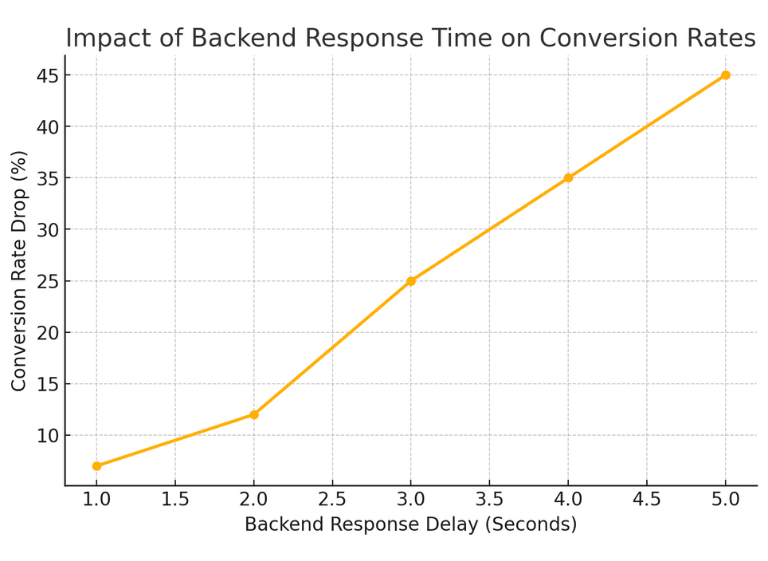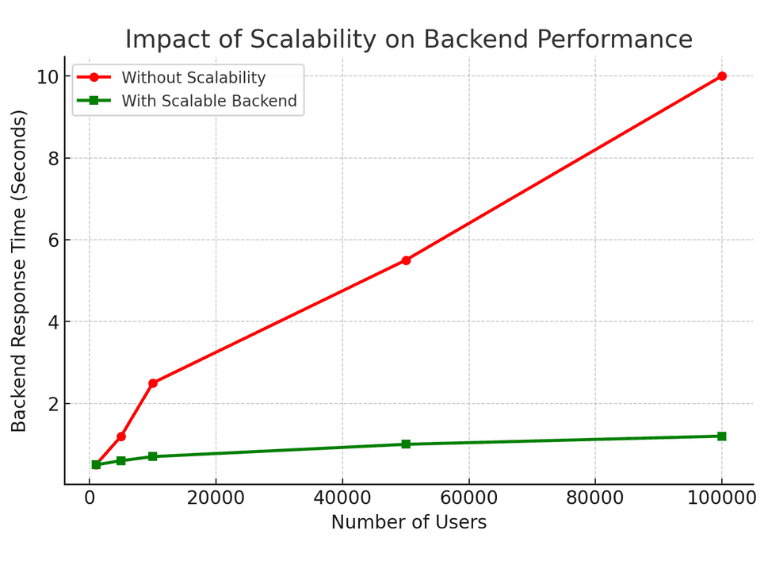Mobile app development
Software development
Performance optimization
Security practices
Backend Development for Business Mobile Apps
Nadiia Sidenko
2025-03-07
Backend development plays a pivotal role in the success of business mobile apps, yet it's often underestimated. While intuitive front-end design attracts users, it’s the backend that drives performance, scalability, and secure data handling. For businesses aiming to grow, integrate third-party services, and retain users, investing in a robust backend is non-negotiable.

This article explains why backend development is critical for business mobile apps and highlights common pitfalls, industry-specific backend needs, and proven strategies for choosing scalable architecture. For a deeper dive into the role of backend systems in digital products, see our analysis in Decoding the Back-End: The Engine Powering Modern Websites.
Why Backend Development Is Critical for Business Mobile Apps
To understand why backend development matters, it’s essential to first distinguish it from frontend development. Each plays a distinct role in mobile app architecture.
Backend vs Frontend in Mobile Apps: Key Differences Explained
A mobile app consists of two fundamental components: the frontend and the backend. The frontend is responsible for what users see and interact with, including UI elements, animations, and navigation. On the other hand, the backend is responsible for handling business logic, storing and processing data, and ensuring seamless communication between the app and external services.
The backend acts as the "brain" of an application, while the frontend serves as its "face." A well-developed backend ensures that app requests are processed efficiently, data is retrieved accurately, and security protocols are enforced. Without a solid backend, even the best-designed mobile app will fail to deliver a smooth user experience.
Why a Strong Backend Is Essential for Mobile App Performance and Scalability
Before diving into specific architectural styles, it's important to understand how different backend approaches can impact scalability and long-term performance.
Monolithic vs Microservices Backend: Key Differences
| Criteria | Monolithic Backend | Microservices Backend |
|---|---|---|
| Architecture | Single, unified codebase | Multiple independent services communicating via APIs |
| Scalability | Difficult to scale individual components | Easier to scale each microservice independently |
| Best Use Cases | Small to medium applications with simple business logic | Large-scale applications requiring modular architecture |
Why a Strong Backend Is Essential for Mobile App Performance and Scalability
Before diving into specific architectural styles, it's important to understand how different backend approaches can impact scalability and long-term performance.
Backend development plays a crucial role in ensuring app performance, data security, and scalability. Business mobile apps must handle a high volume of user interactions, transactions, and data exchanges. A strong backend ensures:
- Efficient data processing, enabling real-time functionality such as live tracking, messaging, and analytics
- Secure authentication and authorization mechanisms to protect sensitive business and user information
- Integration with third-party services such as payment gateways, customer relationship management (CRM) systems, and analytics platforms
- High availability and performance optimization to ensure the app remains fast and responsive under heavy traffic

This graph illustrates the relationship between backend response delay (in seconds) and the conversion rate drop (in percentage) for business mobile applications.
Key Insights from the Graph:
1. X-Axis (Backend Response Delay in Seconds)
- Represents the time it takes for the backend to respond to a user request
- Delays of 1 to 5 seconds are measured, as these are the most common lag ranges in mobile apps
2. Y-Axis (Conversion Rate Drop in Percentage)
- Shows the decrease in conversion rates as backend response time increases
- Data is based on industry studies showing that faster response times correlate with higher user engagement and sales
Why These Numbers Matter?
- A 1-second delay leads to 7% fewer conversions, while a 3+ second delay can cause a 25-45% drop in conversion rates. According to Google’s mobile speed benchmarks, even minor backend delays significantly increase bounce rates and reduce user retention across industries.
- Slow backend processing results in higher user frustration, increased bounce rates, and lost revenue
- Businesses that rely on real-time user interactions (e.g., eCommerce, fintech, SaaS applications) are particularly vulnerable to performance issues
Who Should Care About This?
- App developers optimizing performance for user retention
- Product managers seeking to improve engagement and customer satisfaction
- Business owners who want to maximize revenue and minimize churn in mobile applications
Conclusion: Optimizing backend response times is critical to maintaining high conversion rates. Implementing caching, database indexing, and load balancing can significantly improve app performance and reduce revenue loss.
Conversion Rate Drop vs Backend Response Time
| Backend Response Time | Expected Conversion Rate Impact |
|---|---|
| < 1s | High conversion |
| 1–3s | Moderate conversion |
| > 3s | Low conversion, high bounce risk |
Core Backend Components in Mobile App Architecture
Every business mobile app relies on several backend components to function effectively.
- Databases store and manage user data, product information, order history, and other critical business records. Businesses typically choose between SQL databases (MySQL, PostgreSQL) for structured data or NoSQL databases (MongoDB, Firebase) for flexible data storage
- APIs (Application Programming Interfaces) facilitate communication between the frontend and backend. APIs allow apps to retrieve data from servers, process transactions, and integrate with third-party services
- Servers handle incoming requests, process business logic, and ensure that data flows smoothly between different application layers. Businesses can use cloud-based solutions like AWS, Google Cloud, or Azure to scale their backend infrastructure. Cloud providers like AWS offer well-architected mobile backend guidelines that help businesses design scalable and resilient systems using serverless and microservices principles
- Authentication systems protect user accounts, ensuring secure login and access control. Technologies such as OAuth, JWT (JSON Web Tokens), and two-factor authentication (2FA) help businesses implement secure authentication mechanisms
Popular Backend Technologies
| Technology | Best For | Pros | Cons |
|---|---|---|---|
| Node.js | Real-time applications | Fast performance, lightweight | Single-threaded nature limits heavy computation |
| Python | AI-powered applications | Strong AI & ML support, readable syntax | Slower than compiled languages |
| AWS | Scalable cloud computing | Highly reliable, auto-scaling | Expensive at scale, complex setup |
To learn more about best practices for backend architecture, consider exploring Extreme Programming Practices, which emphasize continuous integration, test-driven development, and scalable infrastructure.
Table: SQL vs NoSQL Databases
| Criteria | SQL Databases | NoSQL Databases |
|---|---|---|
| Structure | Structured, relational (tables, rows, columns) | Flexible, non-relational (documents, key-value, graph, column-store) |
| Scalability | Vertical scaling (adding more power to a single server) | Horizontal scaling (adding more distributed servers) |
| Best Use Cases | Financial apps, eCommerce, CRM, ERP | Real-time analytics, social media, IoT, mobile apps |
| Performance | Slower for unstructured or large datasets | Faster for large, distributed, and real-time datasets apps |
| Examples | MySQL, PostgreSQL, Microsoft SQL Server, Oracle | MongoDB, Firebase, Cassandra, DynamoDB |
Backend Mistakes to Avoid in Mobile App Development
One of the most critical and commonly overlooked mistakes in backend development for mobile apps is the failure to plan for scalability from the start.
Scalability Issues in Mobile App Backend Infrastructure
One of the most common mistakes businesses make is failing to build a scalable backend. As a business grows, the mobile app will need to handle more users, transactions, and data. If the backend is not designed for scalability, it may lead to slow response times, server crashes, and increased maintenance costs.
We’ve seen in practice how building a scalable, cloud-based backend ensures stability under growing traffic—for example, in our work on a real estate financing platform where performance and availability were critical.

This graph illustrates how backend response time (in seconds) changes as the number of users increases, comparing a non-scalable backend versus a scalable backend.
Key Insights from the Graph:
1. X-Axis (Number of Users)
- Represents the growing number of active users interacting with the mobile app backend
- The values range from 1,000 to 100,000 users, representing common scalability challenges for business mobile applications
2. Y-Axis (Backend Response Time in Seconds)
- Indicates how long it takes for the backend to respond to a request
- The red line (Without Scalability) shows a sharp increase in response time, while the green line (With Scalable Backend) remains stable
Why These Numbers Matter?
- Without a scalable backend, response time increases exponentially as user load grows, leading to poor user experience, slow transactions, and app crashes
- A scalable backend architecture (horizontal scaling, load balancing, cloud infrastructure) keeps response times low and consistent, even under heavy traffic
Who Should Care About This?
- Backend developers optimizing app performance
- Business owners ensuring their app can handle growth
- Product managers planning for long-term scalability
Conclusion: Investing in scalability from the start ensures seamless performance, prevents downtime, and allows the app to grow with demand. Businesses relying on real-time interactions (eCommerce, fintech, logistics, SaaS) must prioritize cloud-based infrastructure and horizontal scaling.
Businesses should adopt a cloud-based infrastructure that allows for horizontal scaling, ensuring that additional server resources can be allocated dynamically based on user demand.
Database Optimization Mistakes That Hurt Mobile App Performance
A poorly optimized database can significantly impact app performance. Inefficient database queries, lack of indexing, and redundant data storage can slow down the app and increase operational costs.
To optimize database performance, businesses should:
- Implement indexing and query optimization techniques to reduce data retrieval time
- Choose the right database model based on app requirements (SQL vs NoSQL databases)
- Use caching mechanisms such as Redis or Memcached to speed up frequently accessed data
Security Risks in Mobile App Backend Development
Security is a critical aspect of backend development that businesses cannot afford to overlook. Weak authentication mechanisms, unencrypted data storage, and poor API security can lead to data breaches and compliance violations.
Best practices for backend security include:
- Encrypting sensitive data to prevent unauthorized access
- Implementing strong authentication and authorization measures
- Regularly auditing security protocols and applying updates to patch vulnerabilities
Developers should follow recognized mobile security standards such as those outlined by OWASP to mitigate the most common vulnerabilities in mobile backend systems.
API Integration Pitfalls in Business Mobile App Development
APIs are essential for mobile apps, but poor API management can lead to security risks, performance issues, and integration failures. Common API-related mistakes include:
- Exposing sensitive data without proper authentication
- Not implementing rate limiting, leading to API overuse and system crashes
- Failing to document APIs properly, making future integrations difficult
A well-designed API strategy should include secure authentication methods, rate limiting, and proper documentation to ensure smooth integrations.
How Backend Development Enhances Business Mobile Apps
Different industries rely on backend development in unique ways, depending on their operational needs, data processing requirements, and user expectations. Let’s explore how strong backend systems enable core functionality in sector-specific business apps.
Retail App Backend: Managing Inventory, Payments, and Orders
In the retail industry, a strong backend supports inventory management, secure payment processing, and automated order handling. By integrating real-time stock updates, businesses can avoid overselling products, while a secure payment gateway ensures customer transactions are safe and compliant with industry standards.
Logistics App Backend: Real-Time Tracking and Route Optimization
Logistics and transportation apps require backend systems that enable GPS tracking, route optimization, and real-time shipment updates. A backend that efficiently processes location data and integrates with fleet management systems helps businesses streamline operations and improve delivery accuracy.
Restaurant App Backend: Online Ordering and Table Reservations
For restaurants, a backend handles table reservations, online orders, and customer loyalty programs. A well-structured backend ensures that orders are processed in real time, inventory levels are updated, and promotional offers are seamlessly integrated into the system.
Healthcare App Backend: Data Security and Telemedicine Support
Healthcare mobile apps must comply with strict data security regulations, such as HIPAA. The backend should facilitate encrypted data storage, secure telemedicine consultations, and AI-driven diagnostics while ensuring that patient records remain confidential and accessible only to authorized users.
Companies across various sectors have leveraged scalable backend solutions to optimize operations, as shown in Google Cloud’s mobile case studies.
Table: Common Backend Mistakes and Solutions
| Common Mistake | Consequences | Solution |
|---|---|---|
| Ignoring Scalability | Performance issues as the app grows | Implement cloud-based scaling strategies |
| Poor Database Optimization | Slow queries, high latency | Use indexing, optimize queries, implement caching |
| Weak Security Measures | Data breaches, compliance violations | Use encryption, strong authentication, security audits |
Backend Best Practices to Build Scalable and Secure Business Apps
- Ensure data security by implementing encryption, access controls, and compliance measures such as GDPR and HIPAA.
- Optimize backend performance with caching mechanisms, load balancing, and query optimizations.
- Use API-first development to enable seamless integration with third-party services. Agile principles also apply to backend systems—adopting an agile backend architecture ensures faster iterations and easier adaptability to changing business needs.
- Regularly maintain and monitor backend infrastructure to identify and resolve issues proactively.

Why Backend Development Is Crucial from Day One of App Planning
A mobile app's success hinges not only on user-friendly design but on a resilient backend architecture. A well-structured backend enables seamless functionality, protects sensitive business data, and scales effortlessly as demand grows. Companies that invest in robust backend infrastructure set the foundation for reliable performance, long-term growth, and user satisfaction.
Ultimately, backend development is not an optional add-on — it’s a strategic necessity for any business mobile application aiming for market success and operational efficiency.
This article was updated in July 2025 to reflect the latest trends and practices in backend development for business mobile apps.